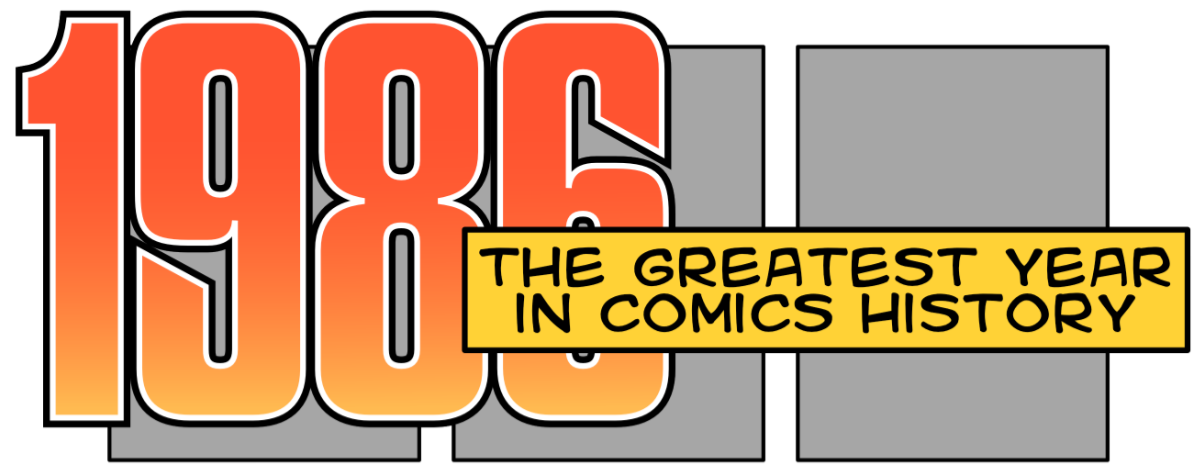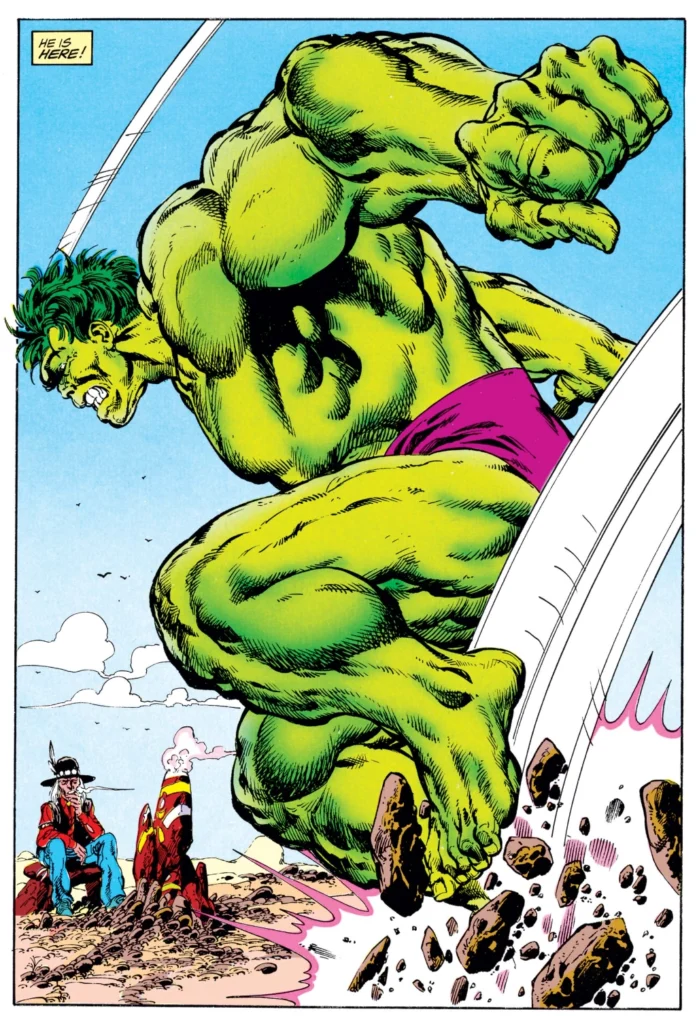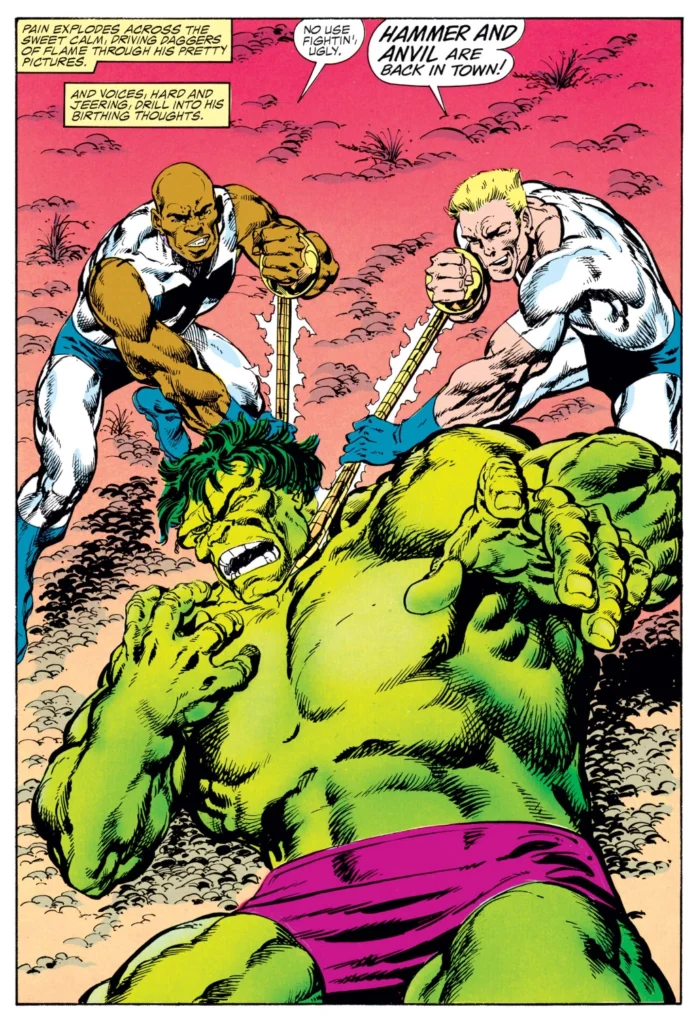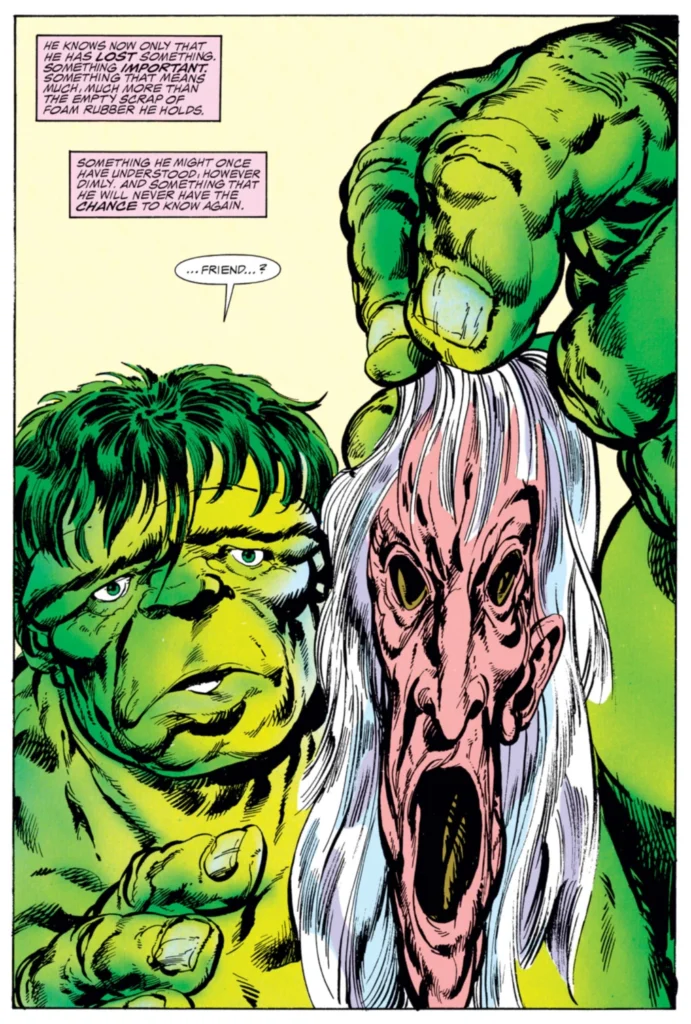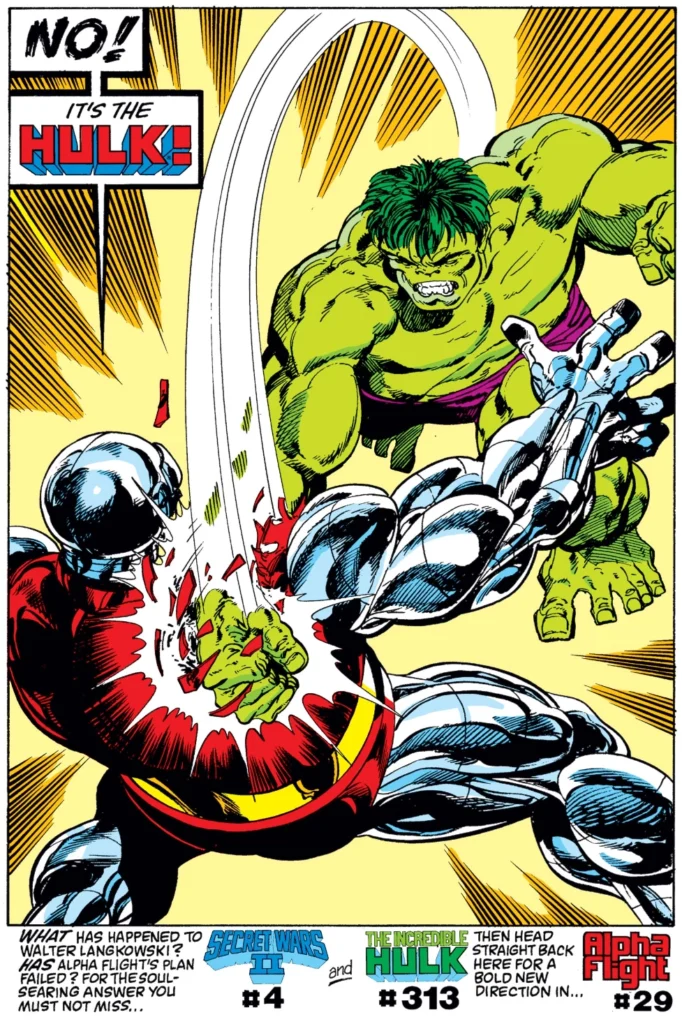
It cannot be denied that by the mid-1980s, John Byrne was a superstar in the comics field. He came to prominence working for Marvel in the 1970s, where, among other titles, he co-wrote (with Chris Claremont) and illustrated The Uncanny X-Men during one of its most formative periods, before coming into his own as the sole writer and artist on Marvel’s flagship title, the Fantastic Four. His flawless draftsmanship, mastery of anatomy and perspective, and innate understanding of the ins and outs of the superhero genre made him one of the first “name above the title” comic book creators. Readers weren’t buying Fantastic Four, they were buying John Byrne’s Fantastic Four.
By 1985, Byrne was writing and drawing two monthly comic books for Marvel (Fantastic Four and Alpha Flight), plus numerous side-projects such as a one-shot She-Hulk graphic novel, The Last Galactus Story (a serialized tale appearing in Marvel’s Epic Illustrated newsstand magazine), and too many covers to list – a John Byrne cover was sure to call attention to what might otherwise be an overlooked title.
As recounted on Byrne’s website, he casually mentioned to Marvel editor-in-chief Jim Shooter that he thought the Incredible Hulk had drifted too far from its core principles and needed a “back to basics” approach. Shooter apparently took this for a pitch and asked him to take over the book as soon as possible. Byrne’s schedule was far too packed to do it, but after giving it some thought he hatched a scheme to swap creative teams between The Incredible Hulk and Alpha Flight, a book he had created but was running out of material for. So with much fanfare, John Byrne took on the reigns of The Incredible Hulk.
The Story So Far
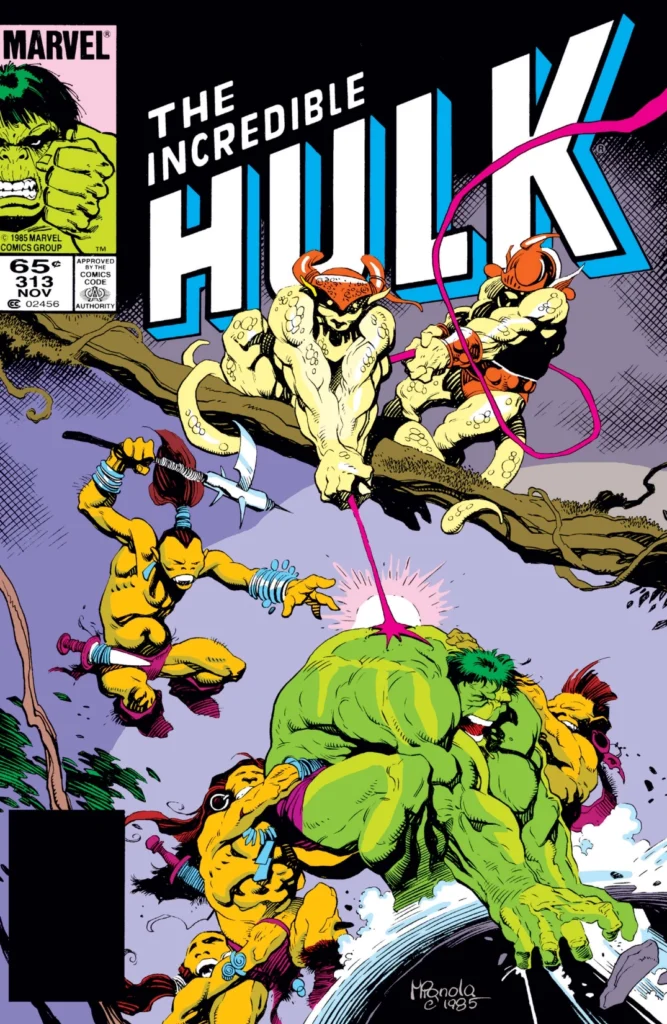
In a storyline that had started just over a year previously, Bruce Banner gave up any hope of controlling his monstrous alter ego and buried his consciousness, leaving the brutish Hulk in full charge. One too many destructive rampages forced Doctor Strange to banish him to another world (an idea that would be revisited much later in Planet Hulk). Strange put an enchantment on the Hulk that allowed him to wander between different dimensions, returning him to a crossroads between realities any time he grew unsatisfied with the world he found himself in.
It sounds like a versatile idea, but it quickly got stale as the majority of worlds the Hulk visited followed a similar fantasy-fairytale template, with too little connection to anything the reader could identify with. Additionally, at the time the prevailing notion was that most comic book stories should be “one and done” – collected editions of comics were not yet common, so stories were written with only the single issue in mind. The stories would reset at the end of each issue, and the following story would always start with the Hulk at the crossroads again.
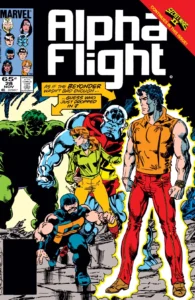
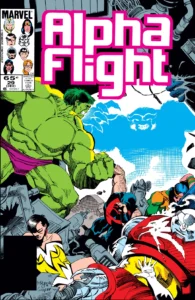
Meanwhile, in Alpha Flight
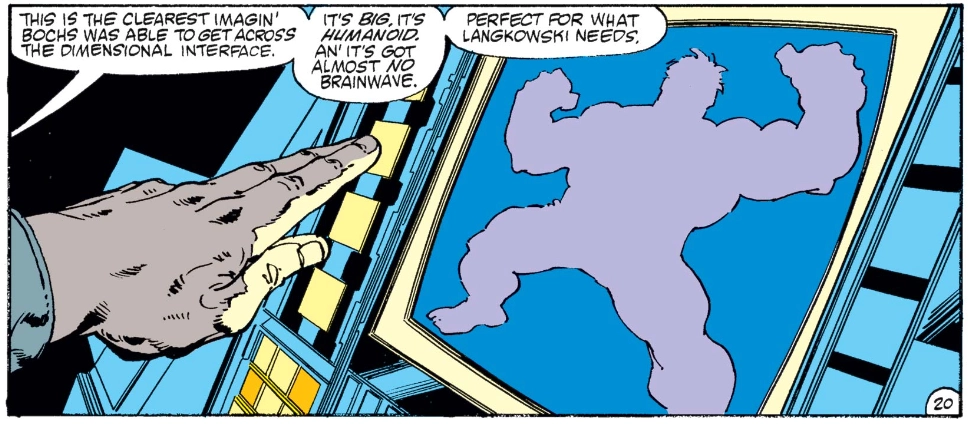
Not content merely to move on to a new title, Byrne (along with Bill Mantlo. the previous Hulk writer) hatched a story that would cross over between the two series. For reasons too complicated to go into here, Alpha Flight #28 finds Sasquatch, Alpha Flight’s resident Hulk-like strongman (who got his powers trying to recreate Bruce Banner’s ill-fated experiments), finds himself a disembodied consciousness in need of a new body. A quick scan of the crossroads between realities turns up a powerful and near-mindless creature who seems perfect for the purpose – that is, until they reel it in and it turns out to be the Hulk, who naturally destroys everything in sight before losing interest and leaping off into the distance. Byrne has always been a plot-focused, problem-solving writer, and it’s neat how he uses elements from the ongoing Alpha Flight storyline to get the Hulk to where he needed him to be in order to start the story he wanted to tell.
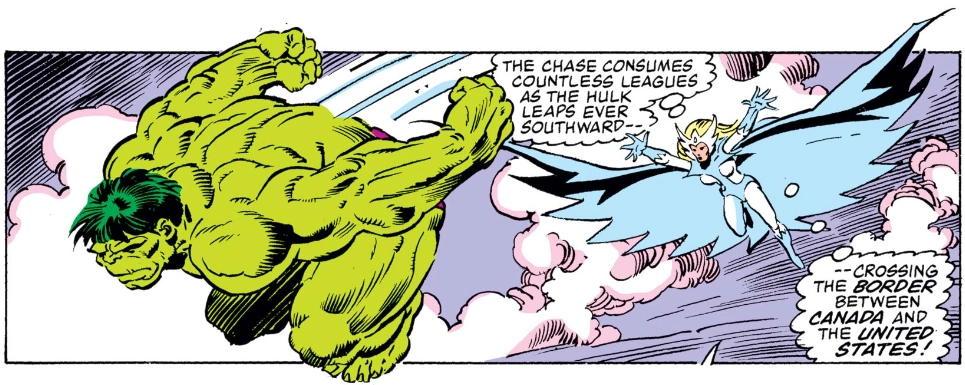
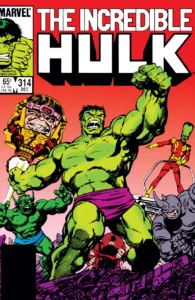
The Incredible Hulk #314 (December 1985)
“Call of the Desert” | “Yesterday’s Sorrows” | “Yesterday’s Foes!”
From the very first page, Byrne’s artwork is BIG. He seems to want to give a sense of how massive the Hulk is, which he accomplishes by drawing the action as large as he can, with rarely more than three or four panels to a page whenever the Hulk is in the scene.
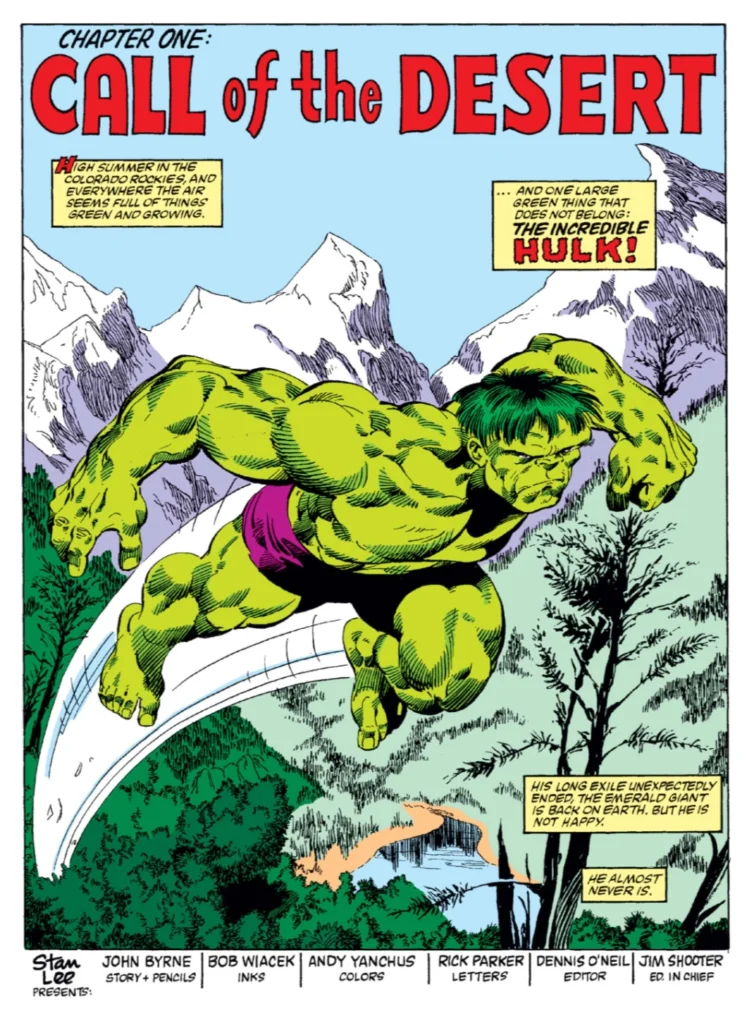
Part of Byrne’s “back to basics” approach was to get the Hulk back to his birthplace. The usual formula for the original Incredible Hulk stories had him wandering the deserts of New Mexico, pursued by the Army and the obsessive General “Thunderbolt” Ross, the Ahab to Hulk’s Moby Dick. In place of General Ross, Byrne drops in Doc Samson, a long standing Incredible Hulk supporting character, as the Hulk’s pursuer. Oddly, while the Hulk’s origin is recapped no less than three times over the next six issues, Doc Samson is given no reintroduction. It seems to be assumed that the reader already knows who he is and why he has a relationship to the Hulk (Samson is yet another scientist who attempted to recreate Banner’s experiments – in this case he has super-strength and long green hair but is otherwise a normal, if colossally egotistical, man).
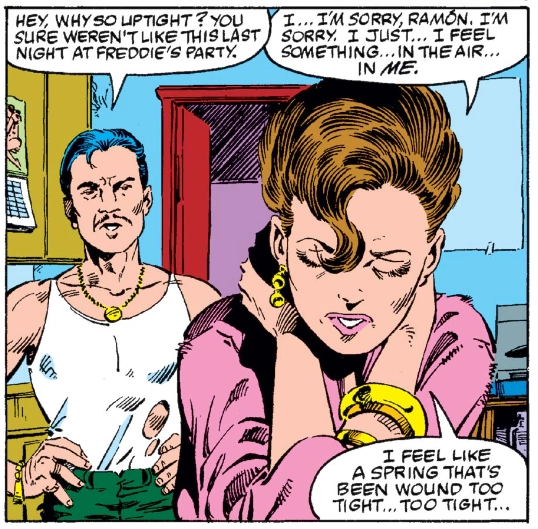
After introducing the setting and a few of the characters, Byrne falls back on a technique that he’s used to great effect in his past work. Byrne would get around the “one and done” mandate that required stories to wrap up in a single 22 page issue by dropping in a single page detailing a mysterious aside that didn’t seem to have anything to do with the story to hand, only to reveal it to be a teaser for a future storyline in the next issue. In this case, we are introduced to an unknown woman who appears to be living in, shall we say “reduced circumstances” and is shocked into action by a news story about the Hulk’s return.
The bulk of this issue features page upon page of glorious fighting, as the Hulk has it out with first Doc Samson, and then what turn out to be hallucinations of many of his classic foes such as the Juggernaut, MODOK, the Rhino, the Abomination and the Leader. Samson uses the distraction to knock out and capture the Hulk, but for what purpose?
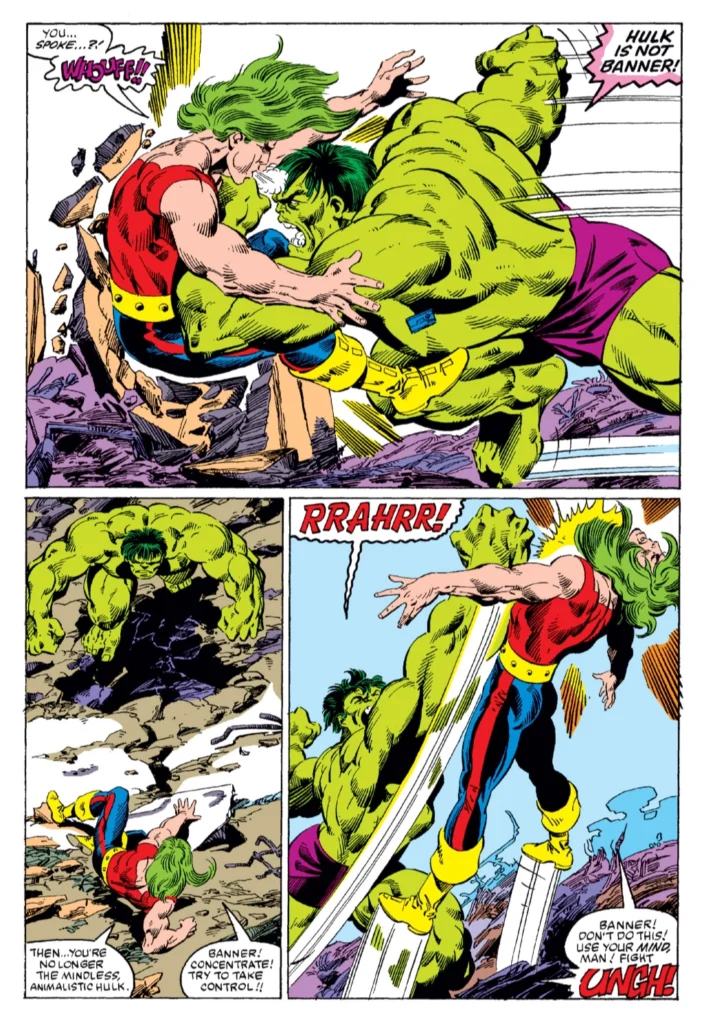
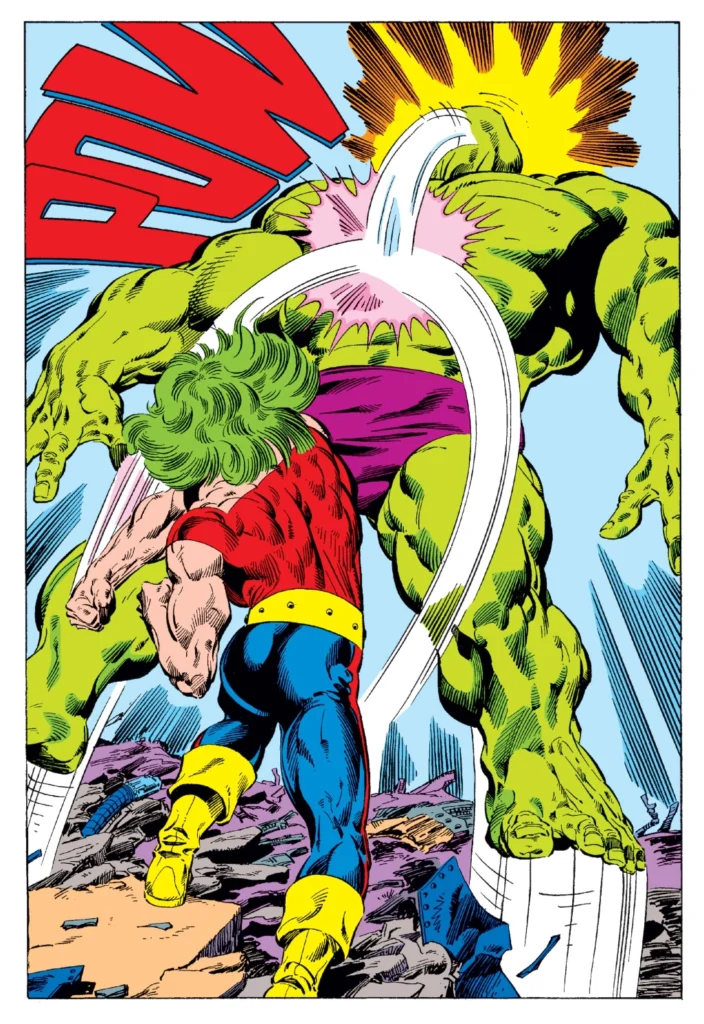
There are eight more pages of fighting in between these two. Pages 12 and 21 from The Incredible Hulk #314, words and pencils by John Byrne, inks by Bob Wiacek. © 1985 Marvel.
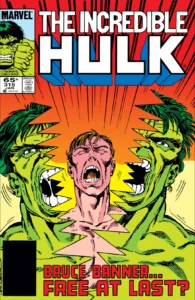
The Incredible Hulk #315 (January 1986)
“A Dramatic Change in the Life of the Incredible Hulk!” | “Freedom!”
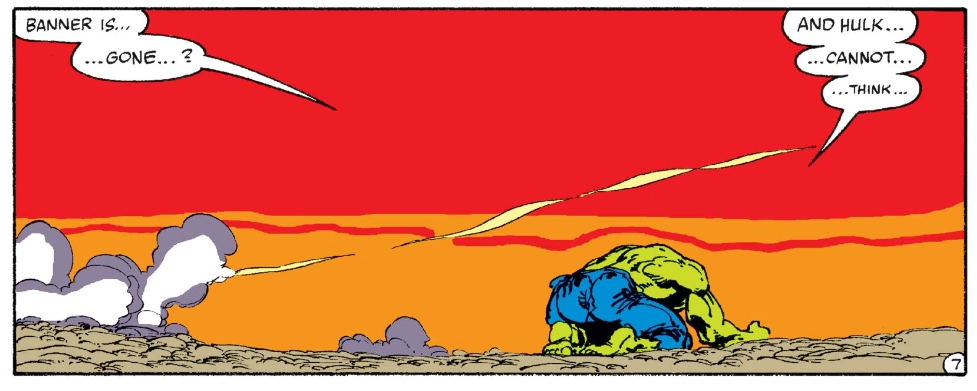
In an intriguing 7-page dream sequence, we learn that Doc Samson has physically separated the Hulk and Bruce Banner into two separate people. Interestingly, the scene seems to be from the Hulk’s point of view rather than Banner, implying that the Hulk has his own individual psyche, rather than simply being an expression of Banner’s rage and other negative emotions. It’s a subtle bit of characterization that may give a hint of what is to come.
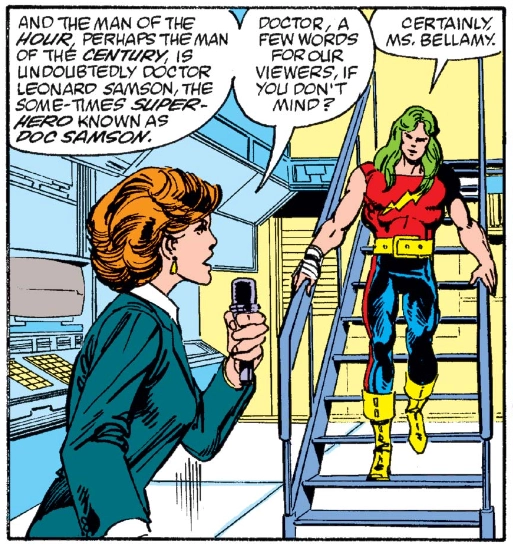
A less subtle bit of characterization is made clear as the scene shifts out of the Hulk’s head and into Doc Samson’s lab, where he demonstrates what a raving narcissist he is by having a TV film crew present during his presumably untested and highly experimental separation of Banner and the Hulk. On the surface, the newscaster is a device, a simple way to get out a bunch of exposition about what’s going on, but it also gives us some telling details about Doc Samson, perhaps reminding us that he’s not quite the altruistic hero that his colorful costume would have us believe.
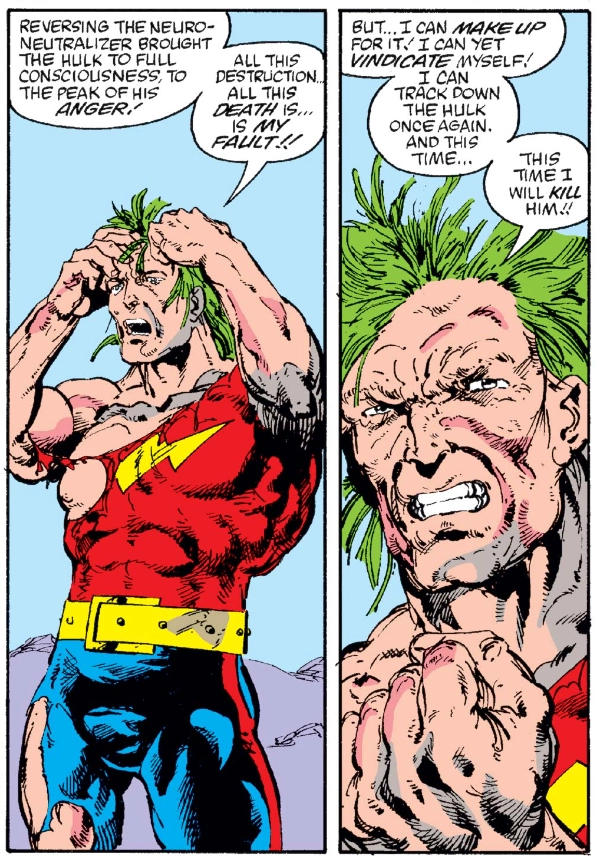
Byrne seems to be making an effort to avoid using thought balloons, preferring a more cinematic approach that relies on dialog and captions to explain what’s going on. For the most part it works, but Doc Samson does seem to talk to himself an awful lot, especially as he moves rapidly from one bad decision to another. Having removed Banner from the equation, Samson sees the now blank-minded Hulk as a fascinating psychiatric subject, while the government concludes that they can destroy him with a clear conscience. Samson naturally decides to help the Hulk escape, only to find that, freed from Banner’s restraining influence, he is now an unstoppable rage machine. Yet somehow, Doc Samson manages to make it all about himself, vowing to vindicate himself by recapturing the Hulk. What a piece of work this guy is…
Finally, we learn that the mysterious woman from the previous issue is none other than Betty Ross, Bruce Banner’s love interest and daughter of his nemesis “Thunderbolt” Ross, who last appeared in the series two years previously. Back to basics, indeed…
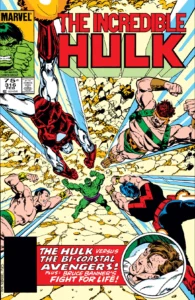
The Incredible Hulk #316 (February 1986)
“Battleground”
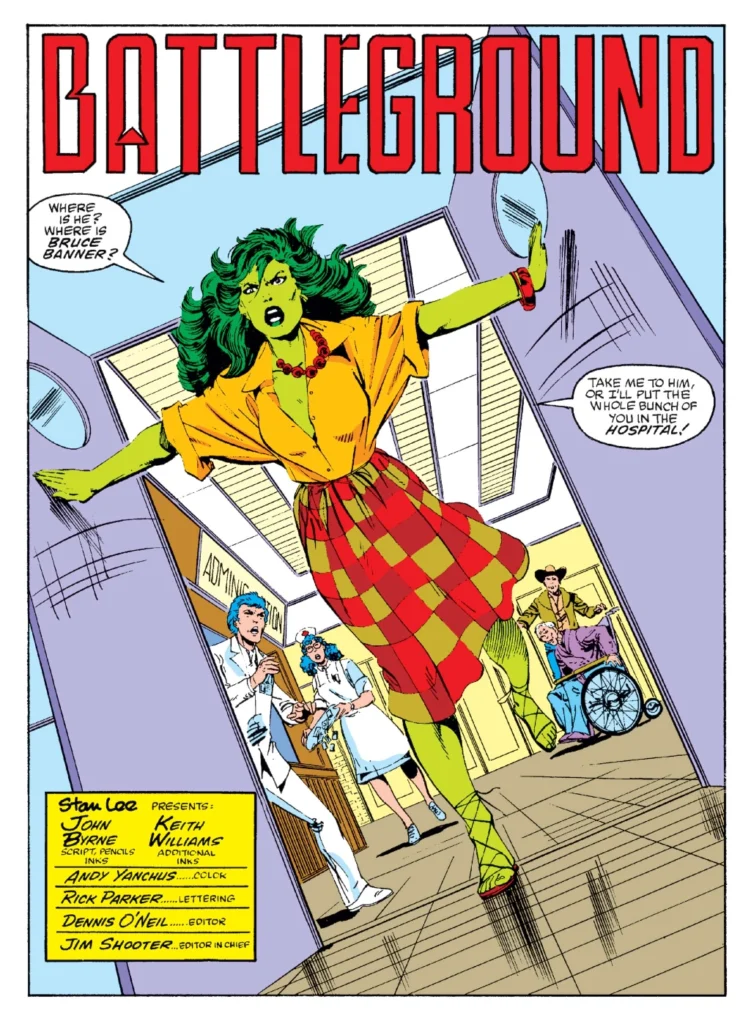
This issue opens with a stunning shot of Jennifer Walters, AKA She-Hulk, a character that Byrne seems to have a lot of affection for. She storms into the hospital where her cousin Bruce lies comatose, and cracks a laugh-out-loud line…which Byrne unfortunately ruins on the next page by explaining the punchline. Unlike many of his contemporaries, Byrne always made an effort to dress his characters in current fashions when not in their superhero gear, and She-Hulk’s ensemble here looks like something right out of a supermarket fashion magazine of the time.
Meanwhile, the mindless Hulk is on the rampage to end all rampages, destroying an entire town. The question of “why don’t the Avengers just turn up and solve the problem” is deftly answered by having the Avengers turn up…and make the problem worse. In a rare acknowledgment of the collateral damage that would have to be caused by a superhero battle, Earth’s Mightiest Heroes are forced to agree to let Doc Samson carry on pursuing the Hulk on his own.
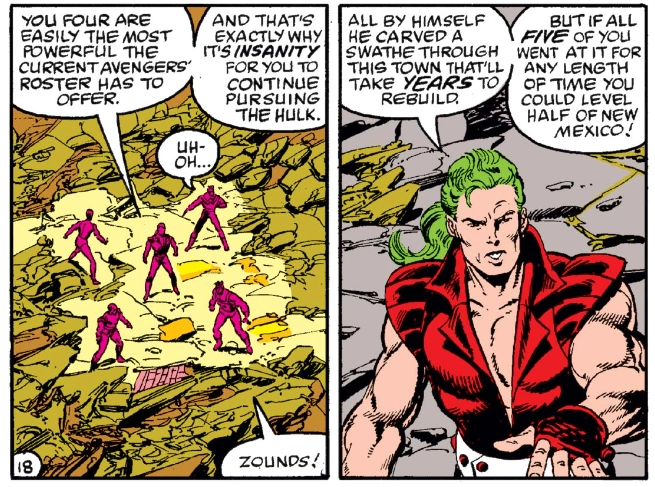
Byrne paces what could have been a tiresome book-length fight scene by intercutting with scenes of She-Hulk and Betty Ross having a quiet conversation at the hospital. Their discussion of whether or not to allow an experimental treatment to try to wake Banner up from his coma provides a break from all the superhero fighting, and also gives Byrne an excuse to do a recap of She-Hulk’s origin, explaining her connection to Banner (still no origin recap for Doc Samson though – seriously, who is this guy?).
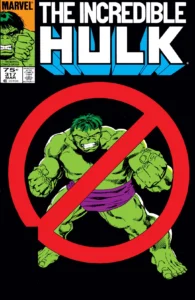
The Incredible Hulk #317 (March 1986)
“You’re Probably Wondering Why I Called You Here Today…”
Now awakened from his coma, Dr. Bruce Banner addresses a variation on the rag-tag group of highly competent misfits that anyone who has ever seen a heist, caper or disaster movie should be familiar with. These eccentric outcasts are being asked to become the new Hulkbusters, the government sanctioned team tasked with capturing the Hulk – it is the final piece in what is sure to become the basic formula of Byrne’s run on the series. In an interesting twist on the original setup for The Incredible Hulk, it will be Banner himself who leads the pursuit of the Hulk.
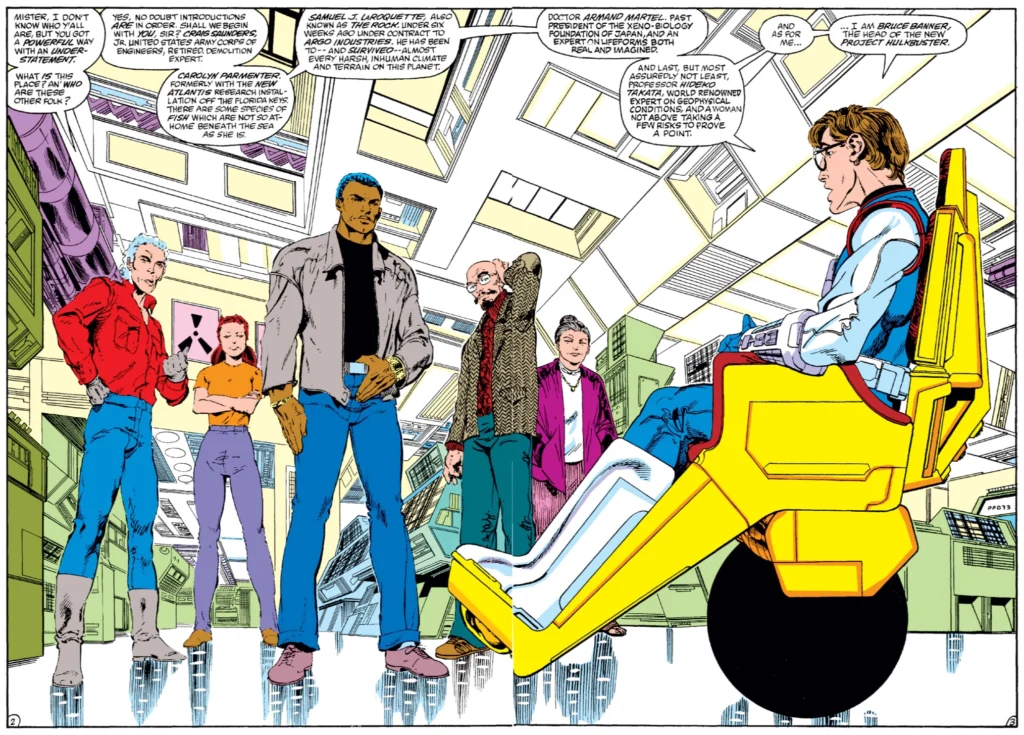
Byrne manages to give the new characters distinct personalities with just a few strokes. In particular, a short conversation scene between two of them, Carolyn and Sam, hints at a past relationship and sets them up to be the likely leaders of the new team.
It is a strength of John Byrne’s writing that he can insert obvious plot devices into his work without them seeming contrived or forced. Case in point: another character dynamic is established in the form of Dianne Bellamy, the news reporter from a few issues back. After her original story was quashed by the government, the scrappy reporter is now prowling the desert with a camera and a gyrocopter, looking for signs of the Hulk. Naturally she runs into Doc Samson, giving him a distraction from his relentless pursuit and an opportunity to be at least a little heroic when she gets in the way during a fight with the Hulk.
This issue establishes several different plot threads that Byrne can pull on as needed: The Hulk’s path of destruction, Doc Samson’s pursuit of the Hulk and run-ins with Dianne Bellamy, the Hulkbusters going out into the field and no doubt coming into conflict with both the Hulk and Samson, and Bruce and Betty rekindling their romance.
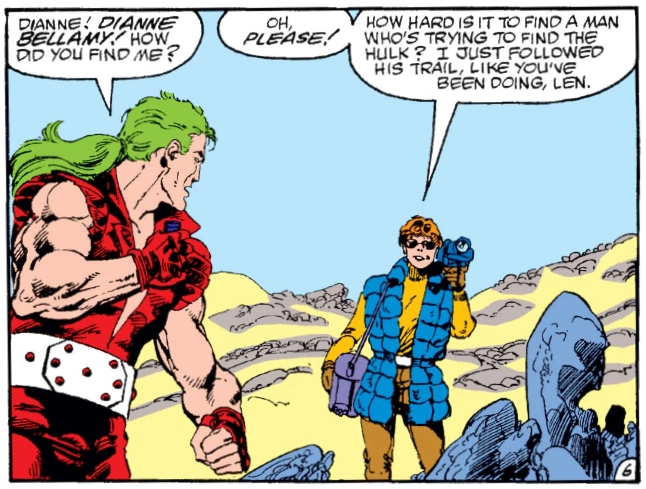
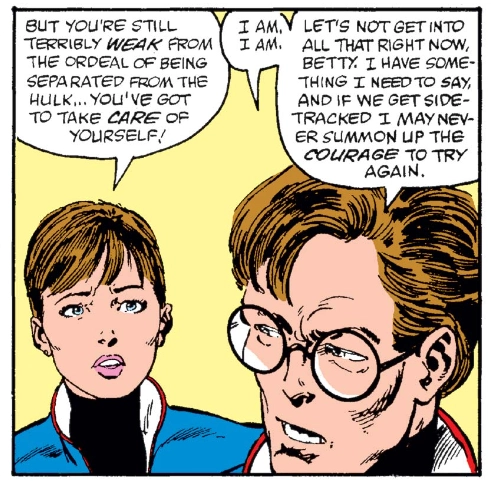
Could romance be in the air? Panels from The Incredible Hulk #317, words and pencils by John Byrne, background inks by Keith Williams. © 1986 Marvel.
Perhaps unsurprisingly for a superhero comic book, the romance is the least interesting storyline. Betty hasn’t really been developed as much more than a wet blanket who constantly worries over Bruce, although it may be Byrne’s intention that she act as a counterpoint to Banner’s obsessive behavior. Banner seems to appreciate her attention, however, as this issue ends with that most egregious source of contrived drama, a marriage proposal…
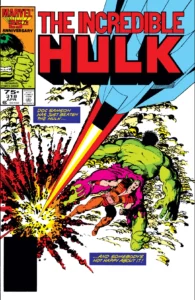
The Incredible Hulk #318 (April 1986)
“Baptism of Fire”
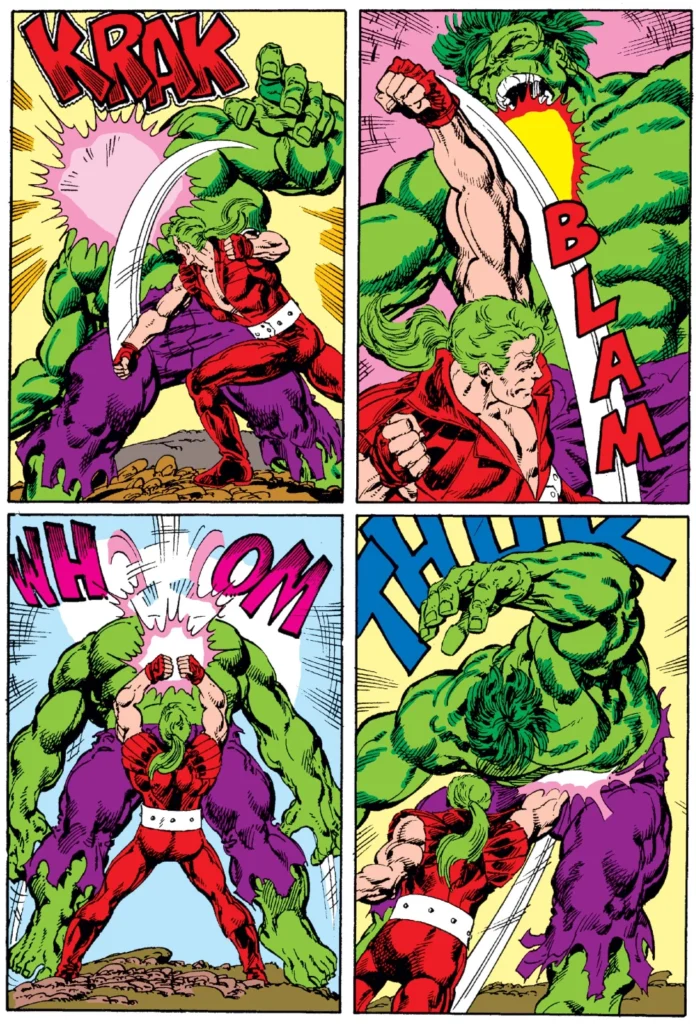
After a jump-scare opening in which Betty Ross mistakes a holographic Hulk for the real thing, Banner takes us on an expositional journey, reminding the readers that the Hulk was originally gray rather than green (a detail that will bear fruit much later, under a different writer). Betty continues to play the part of the concerned lover, but mainly serves a mechanical function as someone for Banner to talk to in order to get out large chunks of exposition.
From here on out, the issue is non-stop action as Doc Samson clobbers what he thinks is the Hulk, only to find that he’s wandered into a training exercise featuring a robotic duplicate. The new Hulkbusters aren’t amused, and decide to test out their walking tank on Doc Samson instead. The scene establishes that the Hulkbusters are not heroes, instead coming off as undisciplined and overly aggressive. This all comes to a head as one of their own, Carolyn, dies during the confrontation – the death is clearly their own fault, but their leader Sam chooses to blame Samson, setting up a highly antagonistic relationship that unfortunately relies (as far too much drama tends to) on adult characters behaving like children.
The earlier development of Carolyn was brief but effective, making her death a bit of an unexpected shock – main characters rarely die in mainstream superhero comics. It demonstrates that since the Hulkbusters all new characters, any of them can die to lend additional weight to scenes that could easily devolve into mindless action.
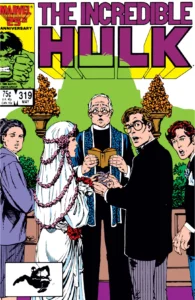
The Incredible Hulk #319 (May 1986)
“Member of the Wedding”
Perhaps mindful that his formula of intercutting battle scenes with talking head exposition might be getting a little stale, Byrne tries something a little different with this issue. Each page is divided in half with a different subplot unfolding on each side, but he keeps it interesting by alternating which storyline is on the top and which is on the bottom, so we get a full page worth of the requisite Hulk battle, split over two half pages, and the same for the wedding story.
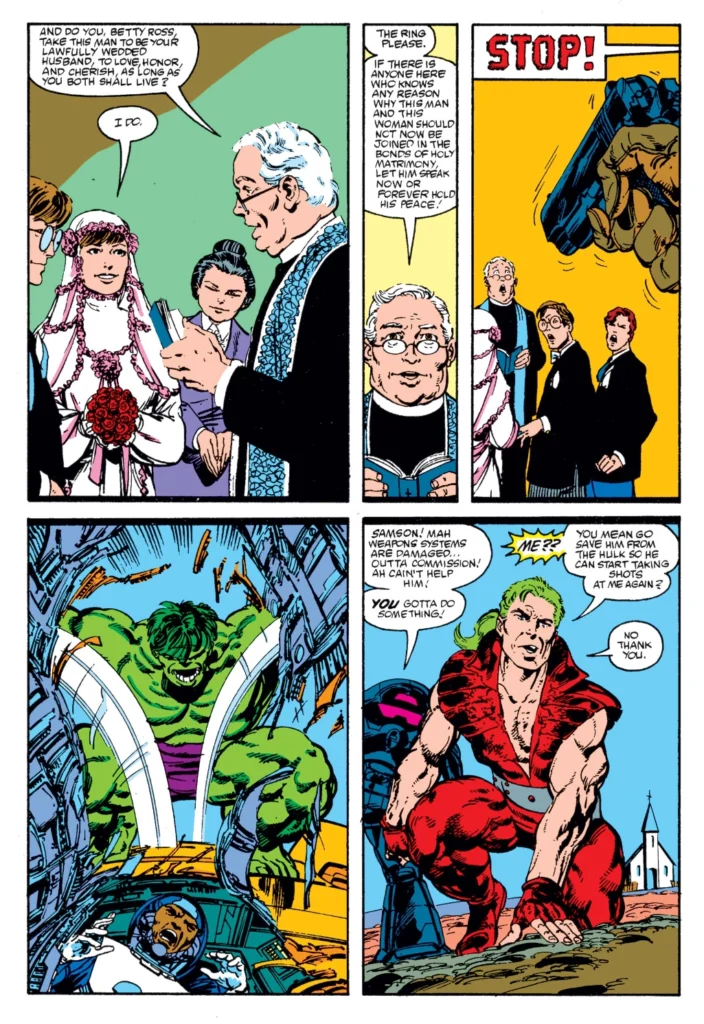
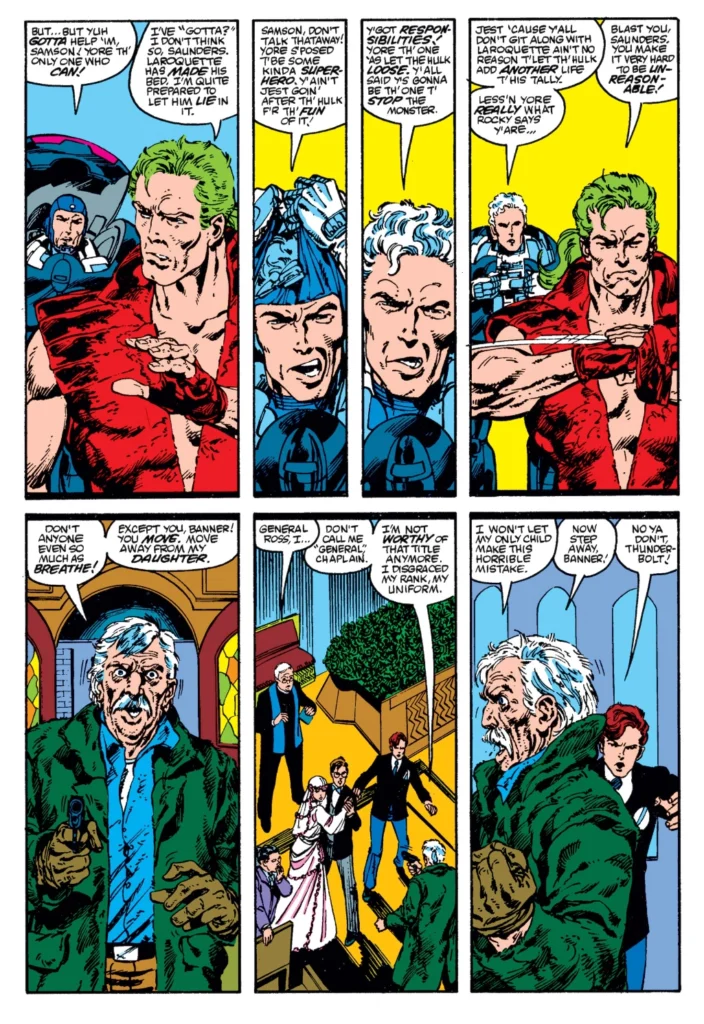
Pages from The Incredible Hulk issue 318, words and pencils by John Byrne, background inks by Keith Williams. © 1986 Marvel.
The battle storyline is more of the same, and despite Byrne’s excellent ability to illustrate action sequences, the repetitiveness and lack of significant resolution – Doc Samson fights the Hulk until he has to rescue a bystander, allowing the Hulk to leap away – is getting worn out by this point. It’s especially problematic in this issue, where all the interesting things are happening in the wedding subplot.
Byrne uses the easily relatable structure of a wedding to reintroduce the final two pieces of his “back to basics” approach, in the form of two more long-standing recurring characters who hadn’t been seen in the pages of The Incredible Hulk for quite some time. The first is Rick Jones, Marvel’s comically ubiquitous sidekick character – seriously, the number of superheroes on his Christmas card list borders on the absurd. Jones was the reason Banner became the Hulk in the first place, so his reappearance provides an excuse for yet another recap of the Hulk’s origin story, but his pre-wedding conversation with Banner seems to be setting up Byrne’s plans for later in the series, as Banner laments his inability to control the power the Hulk gave him before they were separated.
Every dramatic wedding needs its “if there is anyone who knows any reason…” moment, and here is comes from the reappearance of General “Thunderbolt” Ross, Betty’s father and Banner’s former nemesis. The Ross we see here is a disheveled shell of a man, shakily pointing a gun at the wedding party (just how he managed to sneak into what is presumably a high security installation remains a mystery). Throughout his regular appearances in The Incredible Hulk General Ross was the very picture of toxic masculinity, deeply resentful of his daughter’s affection for Banner and constantly wearing him down for being an intellectual. That attitude is of course at the forefront here, but when he accidentally shoots Rick Jones it gives Betty the opportunity to finally stand up to him in a scathing tirade that should do anyone with an overbearing parent proud.
Meanwhile, Doc Samson fights the Hulk some more.
So Then What Happened?
Well, unfortunately that was it. Citing creative differences with Marvel editor-in-chief Jim Shooter, John Byrne left the book, and Marvel entirely, to work on a highly publicized revamp of Superman for DC Comics. Marvel stalwart Al Milgrom was called upon to finish the story, and presumably to hit the reset button so future Hulk writers could take over the character unfettered by Byrne’s changes. To his credit, Milgrom spent four issues working with Byrne’s characters and plot elements and tried to wrap them up as best he could. He’s a competent comics storyteller, but he’s no John Byrne, and the results are a little disappointing in light of what might have been.
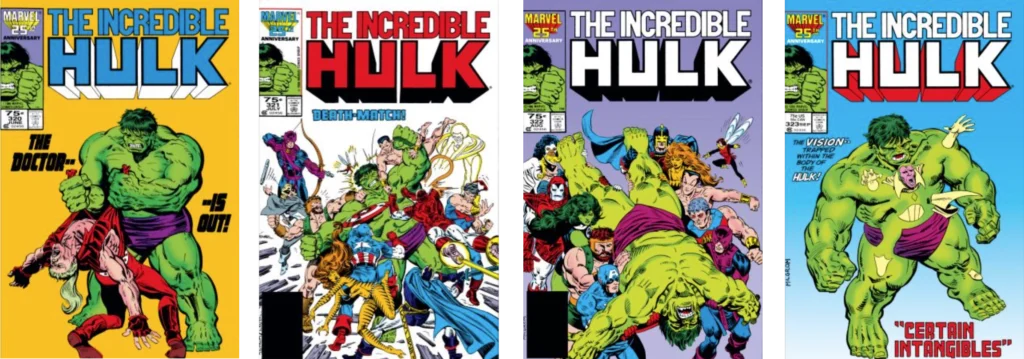
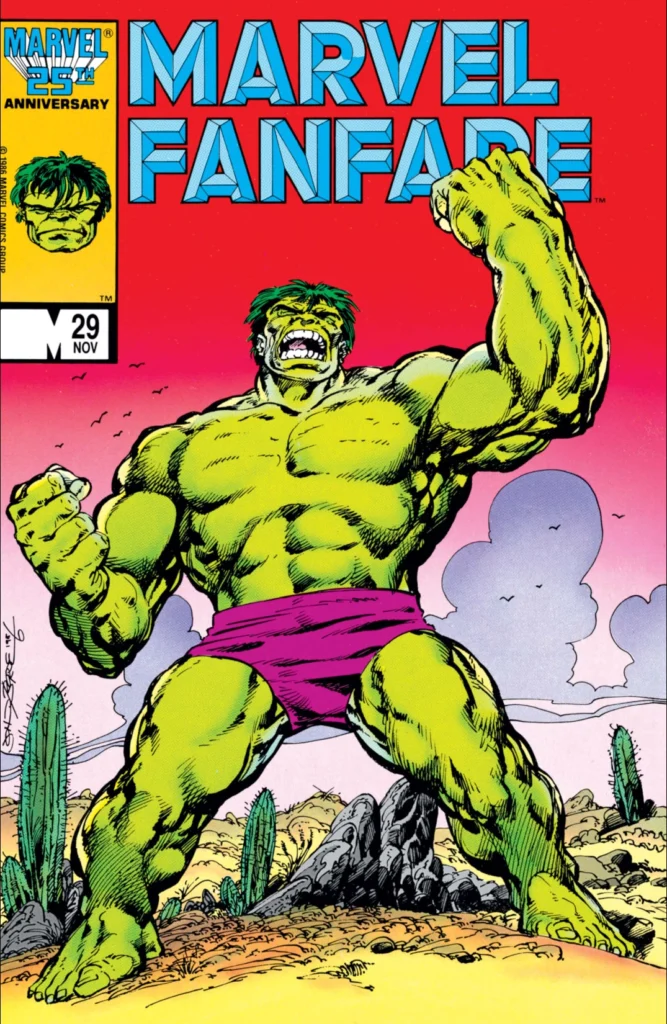
Byrne had completed what was to be The Incredible Hulk #320, another experimental story that was done entirely in full-page panels. As recounted by Byrne on his website in 2015, outgoing Hulk editor Denny O’Neil was afraid to even submit the unusual issue to Marvel’s moody and erratic editor-in-chief, so it sat in a drawer until eventually published as Marvel Fanfare #29, cover-dated November 1986.
The title, “A Terrible Thing to Waste,” has an ironic double meaning in light of Byrne’s aborted run on The Incredible Hulk, and Marvel’s alienation of one of the industry’s biggest stars. The story itself gives us a possible look at where Byrne was taking things – the Hulk speaks for the first time since splitting from Banner, indicating that he might be developing an intellect of his own. Overall it stands as a weird coda to Byrne’s run on The Incredible Hulk, appearing as it did six months later and with a story that was heavily tied into Marvel’s ongoing “Scourge of the Underworld” crossover storyline that ran through most of Marvel’s titles that year but had wrapped up three months prior.
Pages from Marvel Fanfare #29, words and artwork by John Byrne. © 1986 Marvel.
So why publish it at all? It’s probably not a coincidence that it came out right in the middle of Man of Steel, Byrne’s high profile retelling of Superman’s origin.
While not perfect, John Byrne’s sadly short time on The Incredible Hulk had a lot of potential, and hit that sweet spot that comics fans adore: it did something new with the character while at the same time calling back to what made the book so interesting in the first place. It also stands as a cautionary tale about the uneasy relationship between art and commerce, a relationship that seems to be particularly intimate in the comic book industry.
